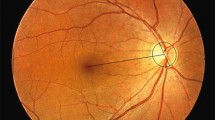Abstract
Purpose
To investigate the relationship between optic disc ovality and horizontal disc tilt.
Methods
The ovality index (the ratio of minimum to maximum disc diameter), horizontal and vertical optic disc tilt, and optic disc torsion were measured on the Heidelberg Retina Tomograph 3 printout in 381 right eyes of 381 normal young subjects. Stereophotographically obvious horizontal tilt and the relationship between the ovality index and horizontal tilt were determined in non-torted discs with an absolute value of disc torsion ≤15°.
Results
The median values of the ovality index, horizontal and vertical tilt, and disc torsion in all subjects were 0.92, 9.0°, 0.0°, and 0.0°, respectively. In the non-torted discs (205 eyes, 53.8 %), a horizontal tilt of ≥20° was stereoscopically obvious. The ovality index was significantly correlated with horizontal tilt (r = −0.276, P < 0.001). The area under the receiver operation curve for the ovality index to discriminate a disc with a horizontal tilt of ≥20° was 0.861. The horizontal disc tilt was significantly correlated with spherical equivalent (r = −0.369, P < 0.001) and axial length (r = 0.277, P < 0.001), but the ovality index was not.
Conclusions
Although the ovality index may be an indicator of stereoscopically obvious horizontal disc tilt, horizontal tilt is more closely related with myopia.



Similar content being viewed by others
References
Marcus MW, de Vries MM, Montolio FG, Jansonius NM. Myopia as a risk factor for open-angle glaucoma: a systematic review and meta-analysis. Ophthalmology. 2011;118:1989–94.
Tay E, Seah SK, Chan SP, Lim AT, Chew SJ, Foster PJ, et al. Optic disk ovality as an index of tilt and its relationship to myopia and perimetry. Am J Ophthalmol. 2005;139:247–52.
How AC, Tan GS, Chan YH, Wong TT, Seah SK, Foster PJ, et al. Population prevalence of tilted and torted optic discs among an adult Chinese population in Singapore. Arch Ophthalmol. 2009;127:894–9.
Hwang YH, Yoo C, Kim YY. Myopic optic disc tilt and the characteristics of peripapillary retinal nerve fiber layer thickness measured by spectral-domain optical coherence tomography. J Glaucoma. 2012;21:260–5.
Tong L, Chan YH, Gazzard G, Loon SC, Fong A, Selvaraj P, et al. Heidelberg retinal tomography of optic disc and nerve fiber layer in singapore children: variations with disc tilt and refractive error. Invest Ophthalmol Vis Sci. 2007;48:4939–44.
Samarawickrama C, Mitchell P, Tong L, Gazzard G, Lim L, Wong TY, et al. Myopia-related optic disc and retinal changes in adolescent children from singapore. Ophthalmology. 2011;118:2050–7.
Uchida H, Yamamoto T, Araie M, Tomita G, Shirakashi M, Yoshikawa K, et al. Topographic characteristics of the optic nerve head measured with scanning laser tomography in normal Japanese subjects. Jpn J Ophthalmol. 2005;49:469–76.
Cankaya AB, Beyazyildiz E. Scanning laser ophthalmoscopy parameters of eyes with exfoliation syndrome. Jpn J Ophthalmol. 2010;54:300–4.
Vongphanit J, Mitchell P, Wang JJ. Population prevalence of tilted optic disks and the relationship of this sign to refractive error. Am J Ophthalmol. 2002;133:679–85.
Park KH, Tomita G, Liou SY, Kitazawa Y. Correlation between peripapillary atrophy and optic nerve damage in normal-tension glaucoma. Ophthalmology. 1996;103:1899–906.
Giuffrè G. Chorioretinal degenerative changes in the tilted disc syndrome. Int Ophthalmol. 1991;15:1–7.
Jonas JB, Kling F, Grundler AE. Optic disc shape, corneal astigmatism and amblyopia. Ophthalmology. 1997;104:1934–7.
Park CY, Kim YT, Kee C. Evaluation of the influence of tilt of optic disc on the measurement of optic disc variables obtained by optical coherence tomography and confocal scanning laser ophthalmoscopy. J Glaucoma. 2005;14:210–4.
Nakazawa M, Kurotaki J, Ruike H. Longterm findings in peripapillary crescent formation in eyes with mild or moderate myopia. Acta Ophthalmol. 2008;86:626–9.
Kim TW, Kim M, Weinreb RN, Woo SJ, Park KH, Hwang JM. Optic disc change with incipient myopia of childhood. Ophthalmology. 2012;119:21–6.
Ohkubo S, Takeda H, Higashide T, Sasaki T, Sugiyama K. A pilot study to detect glaucoma with confocal scanning laser ophthalmoscopy compared with nonmydriatic stereoscopic photography in a community health screening. J Glaucoma. 2007;16:531–8.
Acknowledgments
The authors thank Goji Tomita, MD. PhD., for permission to use the software for measuring PPA parameters on the HRT images.
Author information
Authors and Affiliations
Corresponding author
About this article
Cite this article
Takasaki, H., Higashide, T., Takeda, H. et al. Relationship between optic disc ovality and horizontal disc tilt in normal young subjects. Jpn J Ophthalmol 57, 34–40 (2013). https://doi.org/10.1007/s10384-012-0193-9
Received:
Accepted:
Published:
Issue Date:
DOI: https://doi.org/10.1007/s10384-012-0193-9




